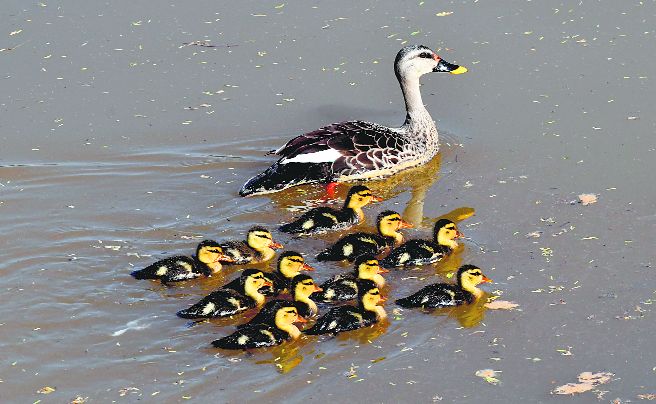
File photo: Ravi Kumar
Lt-Gen Baljit Singh (retd)
“Visual delight” was an understated caption to a photograph carried by Chandigarh Tribune on November 16. That feisty colour photograph, one of its kind, had a parent spot-billed duck proudly putting out on display to the world at large its progeny, not in twins or triplets or quadruplets, but a dazzling, colourful dozen!
As the name implies, the most defining feature of the adult bird is its sturdy long, spatula-shaped bill tipped in polished mustard colour in sharp contrast against the larger part in coal-tar black. And in the case of the male of the species alone, where the beak joins the forehead, there are two conspicuous orange-red, swollen (pimple-like) spots alluding to their spot-billed christening! The female has a single oval-shaped smudge, in faded orange tone instead.
Their plumage further enhances the overall colour scheme with a broad, green stripe over a snow white patch short of the wing-tips, whereas legs and webbed feet come in soft, coral-red shade!
Not to be outmatched, the adorable ducklings steel hearts with pink beaks, offset by bright yellow heads, necks and breasts and a long mascara black eye-stripe. However, as they grow, the yellow plumage changes into sober greyish-white on head and neck, black-spotted breast and reddish-brown above for ease of merging with the aquatic vegetation in their living habitat and survival against predation. But the magic of growth to adulthood lies in the single-toned pink beak transforming into dual colours — mustard and black — and topped, of course, with their signature twin spots.
No matter how diligently the parent strives to shield the perky dozen from nature’s law of ‘tooth and claw’, but raptors will make merry and ultimately only a few will attain adulthood. Occasionally, when a victim may get away but be injured in the struggle, nature has equipped this species with a genetic ability to go under water for recuperation by anchoring around the roots of any aquatic plant but keeping the tip of the beak outside for breathing.
Admittedly, the spot-bills are not a novelty on the Sukhna Lake waters but 12 ducklings in tow are certainly a rarity. They breed twice in the year with an average clutch of seven eggs, but on occasions, even a clutch of 12 is not unusual. The female knows when the last egg is laid and, at once, sits to incubate for the next 24 days, flat. The male watches over her, and once the eggs are hatched, he minds the chicks and teaches them the ways of their world.
Old residents of Chandigarh may remember the late Mr Sharma of the UT’s Health Department, who from a mini water body, downstream of the Sukhna (now developed and inaugurated with much fanfare as the Bird Park), had photographed a spot-bill with her brood but of just two ducklings! That was around 2002, and one of those perky chicks in that endearing image was caught riding piggyback!
Ducks have a fair presence of 32 species among our rich bird life, though only 10 (including spot-bills) are in the permanently residing and breeding category. Regrettably, the pink-headed prima donna resident was lost to extinction way back in 1935. The extinction is forever.
The remaining 22 species have all-time visas to India and pandemics or other calamities notwithstanding, they never default on their annual visits. However, the numbers do vary from year to year as at least seven of the 22 are in the vagrant class who, as their category suggests, are prone to wandering into wrong migratory flyways and often miss out destination India.
How much longer will we enjoy such “visual delights” is a moot point as we seem determined on reckless “development” sans any concerns for the well-being of our natural world. Would the architects of that development paradigm for once listen to what a poet had pleaded:
“What would the world
be once bereft,
Of wet & wilderness?
Let them be left.
O, let them be left,
wilderness & wet,
Long live the weeds & the wilderness yet.”
Join Whatsapp Channel of The Tribune for latest updates.


























